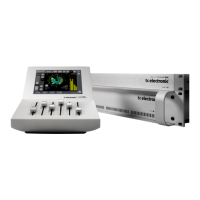66
brICkwAll 2
Green Limiter LED indicator
Indicates bit transparency (read introduction for details).
Threshold
Range:Off,0dBFSto-25dBFS
When the input level exceeds the Threshold, the signal
will be attenuated. Gain reduction meters at the bottom of
the display display the max amount of reduction applied
toeitherofthechannels.WhenLinkisactive,thesame
amount of reduction is used in both channels.
Note:ThearchitectureofBrickwall2enablesbit
transparency to be obtained for any limiting Threshold
betweenFullScaleand-25dBFS.
In CD mastering it is common practice to allow level
todigitalFullScaleonasamplebysamplebasis.
This has the consequence that downstream
equipment will behave unpredictably, and in many
casesadddistortionyoudon’thear.Thedistortionis
not harmonic, can be quite severe (more than 10%) and
cause early listening fatigue. Consult the Tech Library at
the TC website for more details. To get rid of most
distortionproblemsinmostcases,makesurethe
Upsamplekeyispushed(green).Thresholdcannowbe
setsafelyat0.0dBFS,whileBrickwall2stilltakescareof
peaksthatwouldotherwisecausedistortion.The
alternativeistodetectonlysinglesamples(Upsample
grey),likemostprocessorsdo,andlowertheThresholdby
2-3 dB to obtain the same degree of low distortion
downstream performance. Besides from post production
andbroadcastwork,atleastonemasteringsituationexists
whereyoushouldconsideralowerThresholdthan0dBFS
with upsampling engaged: When dealing with material that
will be subsequently low bit-rate data reduced. In such
casestryaround-2dBFS,andlistenthroughtheencoder
and decoder
Softclip
Range:Off,+18dB,+12dB,+6dB,0dB,-6dB,-12dB
When the post Gain level exceeds the threshold set, Soft
Clip is activated. When Soft Clip is in operation, the red
indications above the Gain Reduction meters light up.
Soft Clip deliberately adds harmonic distortion, and
may be balanced against the adaptive limiter for
more apparent loudness, or as an effect. However,
when processing sensitive material, and for live
applications, it is recommended to turn off Soft Clip
to avoid bad surprises.
Upsample
Whenactivated(green)Brickwall2operatesat5times
upsampling (regardless of System sample rate) to detect
andremoveintersamplepeaksabovetheThreshold.The
I/O meters are constantly upsampling to give an indication
of potential downstream distortion problems at the input as
well as the output. See the Threshold description for more
information.
Adaptive
Manydifferentobjectivesexistwhenitcomestopeak
limitingaudio.Fromtakingcareofafewpeaksinagentle
waytopushinguptheaverage/peakratioinordertoraise
the apparent loudness, for voice cut-through or a dozen
otherreasons.Brickwall2extendstheadaptiverelease
timecontrolofBrickwall1toincludenumerousnewinternal
variables,tomakethealgorithmrespondintelligentlyfora
numberofapplications.ActivateAdaptive(green)totake
advantage of the different Profiles.
Profile
Range:Dynamic,Soft,Universal,Loud,Voice.
TheadaptiveProfilesallowyoutotellBrickwall2whatyour
intentions are. The selected Profile is only active when
Adaptive is pushed (green).
Several internal variables are dynamically updated based
on the Profile chosen, so distortion is perceived (and
measured) to be as low as possible for a given loudness,
andreductioninaverage/peakratio.Maximumperceived
distortion tolerated is different from Profile to Profile. The
multi-dimensional parameter-space is fully continuos to
avoid situations where distortion could occur, or where
processing is suddenly altered without a detectible cause.
Acquaintance yourself with the different Profiles to have
them at hand when called for by a specific application.
The Dynamic Profile offers gentle processing with
minimumstaticanddynamicdistortion.It’safirstchoicefor
audiophile limiting, for instance with classical music, choir
etc.
The Soft Profile also prioritizes low static and dynamic
distortion over loudness, and is typically suitable for
acoustic music with natural transients and ambience, as
well as live applications.
TheUniversalProfilehasahighertoleranceforperceived
distortion than Dynamic and Soft. It is still magnitudes
better than analog designs, but may be on the aggressive
side for sensitive music. It is a good choice for starters, and
inproductionwhereyoudon’tknowwhattoexpect.
The Loud Profile again has a higher tolerance for perceived
distortion, and is therefore better suited for production and
mastering rather than live applications.
The Voice Profile is targeted human voice, and adapts
welltoasymmetricalsignals.Usedoncompositematerial,
perceivable distortion is to be expected with large ratios of
limiting.
Release
Range: 20 ms to 7 sec.
Because dynamic release times are included with the
adaptive profiles, Release becomes inactive when Adaptive
is selected.

